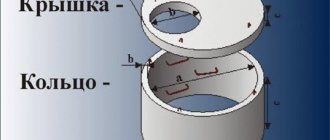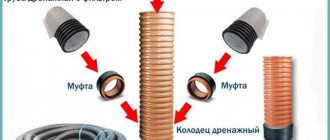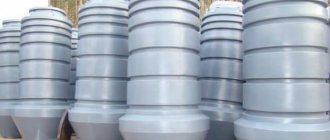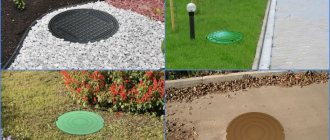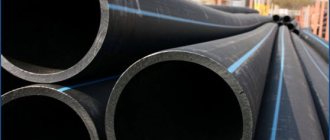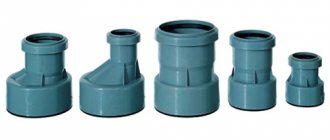Plastic wells are gaining more and more popularity and are rapidly replacing their reinforced concrete counterparts. One of the main arguments for this is the ease of working with plastic products, their reliability and ease of operation and maintenance.
A well made of polymer materials (plastic, polyethylene, etc.) serves to collect and accumulate wastewater from the sewer system, allows you to monitor the performance of the system, etc. In the article we will consider the features of these structures, their classification and much more.
Design features and production standards
Regardless of the type of material used, the design of sewer wells is the same. The structure is a cylindrical shaft sunk into the ground, at the bottom of which there is a kineta - a tray for two or three pipes with wastewater.
One of the mandatory conditions for the use and arrangement of plastic wells for sewage is to ensure the free movement of water
The length of the structure can be adjusted using extensions and retractable shafts. To gain the required length of the structure, they are joined together, creating a strong and hermetically sealed connection.
Often, sliding extension models are used to expand the structure. Acting as connecting elements, in parallel with this they serve as a continuation of the wall of the structure.
Depending on operating conditions, sewer pipes can have different shapes, bends and be equipped with different branches.
The upper part of the well is equipped with a ceiling with a hatch. When installing plastic wells, it is quite logical to choose hatches made of polymers, thanks to which it is possible to ensure equally greater durability of the entire structure.
The dimensions of the plastic models correspond to the dimensions of their cast iron counterparts. When choosing a hatch, they are guided by its functionality.
Depending on the degree of withstanding load, all types of sewer manholes are divided into 4 categories:
- Standard “A15” is used for installation on green areas and pedestrian paths. It can withstand up to one and a half tons.
- “B125” is installed on sidewalks and in park areas and parking lots, where the load weight does not exceed 12.5 tons.
- “S250” is used in the construction of sewers, which are laid under city roads. The products can withstand loads of up to 25 tons.
- “D400” is the most durable structure, capable of supporting up to 40 tons, designed for highways.
Hatches of the “A15” standard can be installed directly on the well shaft, and their analogues of the “B125”, “C250” and “D400” categories can be installed on a discharge ring or a retractable telescopic pipe.
The manhole cover prevents large construction debris and other foreign objects from entering the shaft, making the operation of the structure safer
The neck is a transitional element between the shaft and the hatch. Its main purpose is to accept and compensate for external loads that can damage the mine and the pipes leading to it. For this reason, it is a corrugated or telescopic structure.
The telescopic part of the shaft can be extended, taking the most convenient position for inspecting the condition of the wall surface and providing access during repair work. The relief ring is threaded at both ends, making the connection as tight as possible.
There are holes in the walls of the structure for connecting the inlet and outlet pipes.
To prevent the seepage of groundwater into the shaft cavity or the seepage of wastewater from it, the walls of the well are sealed
Depending on the size of the structure, wells are of two types:
- Up to 1 m in diameter with a maintenance-free shaft. Compact inspection structures are installed at shallow depths.
- Diameter over 1 m . The design allows for easy maintenance of the equipment and, if necessary, repair of the structure.
The well itself is made of the same material that is used in the production of ordinary sewer pipes. It can be structured or two-layer polyvinyl chloride (PVC), polyethylene (PE), polypropylene (PP).
Polymers created using modern technologies are chemically resistant materials and therefore do not pose a danger to the environment
Models made of corrugated plastic are no less popular. This solution simplifies the task of adjusting the height of the tank and makes it possible to partially compensate for the load on the bottom, thereby significantly extending the service life of the structure.
Both types of wells are available with both single and double walls. To resist soil compression from the outside, the products are equipped with stiffeners.
Restrictions
Plastic wells cannot be installed everywhere. For example, in earthquake-prone areas with points above 7, it is better not to use plastic. The same applies to areas in the North with permafrost and air temperatures below -50 degrees.
If the well is old
When the need arises to revive wells or buildings that are unsuitable for drinking for technical needs, then large-diameter pipes made of polymer parts will help to cope with the task.
Most of all, buildings made of wood, brick, and concrete need restoration, which, under the influence of the temporary factor, are destroyed, covered with mold, and rot. Concrete structures in the connecting parts of the segments shift and leak. In addition, silt often appears at the bottom, and the water loses its suitability.
Thanks to polypropylene and polyethylene rings of a different diameter towards reduction, it is possible to sanitize and deepen the well, thus returning life to it.
The working process is as follows:
The water needs to be pumped out.- The bottom filter, consisting of crushed stone or stones, must be removed down to the sand.
- Rings with a diameter of 850-950 mm are connected using waterproof sealant.
- A plastic shaft is lowered into an old shaft.
- The excess space should be filled with a mixture of sand and gravel, not forgetting about compaction.
- A filter layer is formed at the bottom.
With this method of resuscitating an old well, you can significantly save not only labor costs, but also money costs.
Well size
The height of well rings can vary from 50 to 150 cm. The higher the indicator, the more weight the structure has. This becomes the main reason for choosing plastic rings with a minimum height, which of course allows for installation alone.
It is recommended to buy small structures so as not to overpay and look for the so-called “golden mean”, especially for the country.
One of the important parameters is the diameter of the ring. A pipe is considered large if its diameter exceeds 50 mm. The standard diameters of the ECOSIS-850/95 model are 800 and 850 mm on the inner and outer sides, respectively. ECOSIS-950 has 900 and 950 mm, ECOSIS 730 has 690 and 730 mm. The cross-sectional size is almost always 25 mm.
There are also differences in rigidity:
- SN2 is suitable for depths up to 2 m and diameters 600/900/1500 mm;
- SN4 – from 2 to 4 m with diameters of 680/970/1600 mm;
- SN6 – 4-6 m and 700/1000/1800 mm;
- SN8 – 6-8 m, diameter same as SN6;
- SN12 – 8-12 m, with a diameter of 800/1200/2200 mm;
- SN14 – 12-16 m, 850/1300/2400 mm.
It is important to correctly calculate the size of the well, which should not be adjacent to the rings. The minimum width margin is 50 mm, which is subsequently filled in.
Advantages and disadvantages of plastic models
Structures made from composites with a polymer base are in no way inferior to traditional reinforced concrete ring-shaped modules. And in some respects, polyethylene and polyvinyl chloride wells are even superior.
Among the undeniable advantages of plastic wells for arranging a sewage system, it is worth highlighting:
- Affordable price. The price, depending on the dimensions of the structure, types of plastic and the number of pipes, varies from 5 to 50 thousand rubles.
- Lightweight design. The weight of a product, even with a diameter of more than one meter, does not exceed 100 kg.
- High compressive strength . The walls of the structure are able to withstand high pressure created both inside and outside.
- Easy to transport and install. Installation of the structure can be completed without the involvement of additional labor and the use of small-scale mechanization.
- Low thermal conductivity . Polymer formations are resistant to high temperatures. The tray part of the structure is also characterized by increased wear resistance. The only exception is silting and overgrowing of elements.
- Resistance to corrosion and frost. A plastic well or polymer liner manufactured according to standards can withstand down to -60°C without loss of practical qualities.
With proper use, polymer products can last over half a century.
Many owners of country houses value plastic models for their ease of installation, ease of maintenance and reasonable cost.
Not so long ago, products made from polyvinyl chloride were considered not strong enough and frost-resistant in comparison with concrete structures. But modern compositions can easily withstand frosts down to -70°C, so they can be used in any climate zone.
The only drawback of plastic structures is that, although they have thick walls and additional stiffening ribs, their installation should be carried out extremely carefully, since there is a risk of deforming the container.
In addition, in most cases they can be repaired. Any chip or crack on the wall leads to the disposal of the product. For this reason, it is extremely important to choose only high-quality and durable products.
Additional products
It is convenient when, in the absence of a centralized water supply, a personal water supply appears so as not to run with a bucket to the well. Therefore, the issue of installing a pump with a pressure regulator is relevant, so you can use water from the tap at home.
To do this, you will need pipes whose cost will not cause significant damage to the family budget. The pump can be deep-well or centrifugal. In the first option, a hose is connected, which is led home, and the device itself is lowered using a cable to the bottom of the well. Today it is possible to control the pump while in the house, the reviews are positive.
Centrifugal models are usually located in the basements of the house, and a large diameter hose is connected to them to collect water.
Today, the use of a plastic well as an autonomous water supply for a private house is a modern solution. The design is easy to install, has a long service life, and the cost quickly pays off.
Types of sewer wells
According to their purpose, polymer sewer wells are divided into three types: inspection, absorption and water intake.
Viewing models with kinets
Inspection models are mounted on potentially dangerous sections of the pipeline. Their main purpose is to provide access for monitoring the condition of the system, placement of special equipment and the need for maintenance of the structure. Not a single sewer pipeline can do without them.
They must be installed in the following places:
- turning the highway;
- branch connections;
- changing the slope and diameter of pipes.
One inspection well can combine up to three or four traffic flows.
The main element of the inspection well is a small shaft, the upper part of which is equipped with a hatch, and the bottom is equipped with a tray part with special grooves (+)
When installing a sewer system, plastic inspection wells are placed at a distance from each other, regulated by regulatory documentation. The larger the diameters of the installed hydraulic structures, the greater the normatively permissible distance between them.
Additional information on different types of sewer inspection wells is presented in this article.
Absorption drainage structures
Structures of this type are installed where it is not possible to easily drain wastewater. They are cylindrical plastic shafts two meters deep and one and a half meters in diameter.
Unlike inspection wells, absorption-type models do not require the installation of showers. Instead, the bottom of the tanks is equipped with a mesh or lined with materials that have a drainage effect: gravel, crushed stone or crushed brick.
The same material is also used as coating for the outer walls of the well.
Wastewater, entering the absorption tank, is filtered through a drainage layer lined at the bottom and, in a purified form, gradually seeps into the ground
The minimum height for inserting drainage pipes into the walls of a plastic well is 40 cm. Thanks to this solution, the bottom of the tank, in addition to its main task, acts as a sand trap, which catches settling sand particles and other inclusions present in the water.
You can build a simple drainage well with your own hands, for more details, see the article - How to make a drainage well with your own hands and connect pipes to it
Water receiving storage tanks
The main function of water intake wells is to accumulate wastewater until it is pumped out, removed and transferred to treatment facilities. The “final destination” option depends on the degree of water contamination.
Since storage tanks are designed to hold tons of liquid, they are quite impressive in size.
The dimensional parameters of the plastic structure are determined by the daily productivity of the sewer system and the volume of incoming water
Water receiving plastic tanks have completely sealed walls and bottom. One of the prerequisites for installing water intake wells is that the lid is sealed.
This is necessary in order to prevent sewer overflow after heavy rainfall.
Reanimation of old well shafts
Using plastic wells, you can restore old water intake structures made of concrete or wood. If there is an ancient collapsed well on the site, its use will save on geological exploration.
The procedure for resuscitating an old well shaft is carried out in the following sequence of operations:
- Pump out the water and dismantle the old fittings.
- The sediment, bottom filter and part of the soil are removed.
- Geotextiles and crushed stone are used to strengthen the bottom.
- Install a well column of the required length and diameter.
- After lowering the assembled structure into the old shaft, the space between the two columns is filled with gravel and sand.
- The bottom of the well is equipped with a new bottom filter.
- It is convenient to pump water with a submersible pump lowered inside. This procedure is stopped only after clear water appears.
Plastic well on the site of an old concrete well
Criteria for choosing wisely
The price of polymer wells consists of three main parameters:
- Quality of material and wall thickness.
- Dimensions of the structure (internal diameter and height).
- Number of pipes.
Monolithic and prefabricated models are found on sale. The price of monolithic products is an order of magnitude lower than their prefabricated counterparts.
Wells with a monolithic body are used in cases where it is necessary to ensure high compressive strength of the walls of the structure.
The monolithic body of the plastic well is highly durable and sealed, but it cannot be expanded to increase the productivity of the structure
Due to the static internal volume of the structure, when choosing wells with a monolithic body, it is important to correctly assess the volume of water that will flow into it.
Please note that there are models in which the inlet pipes are already built-in. But there are also options where you need to insert the inlet and outlet pipes yourself.
Prefabricated structures allow you to create wells of any height. They consist of component parts, each of which is equipped with an O-ring that ensures the tightness of the structure.
The flexibility and tightness of the structure depends on the number of parts: the more structural elements, the higher the flexibility, but also the greater the likelihood of leaks.
When purchasing a plastic well for draining technical waste, pay attention to the type of material used. It must be resistant to aggressive environments, since during operation it will be exposed to the organic solvents present in it.
Models made of polyvinyl chloride are famous for their non-flammability and high resistance to chemicals. If you need high tightness and resistance to temperature changes, you should choose models made of polyethylene. They perfectly compensate for soil pressure in the cold season.
Even if the water in the cavity of polyvinyl chloride tanks freezes, they do not violate their integrity, and after the liquid thaws, they return to their original shape
On soft soils, where there is a high probability of loading on the walls of a hydraulic structure, it is recommended to install wells made of polypropylene. They have high wear resistance and ductility. They can be welded.
You shouldn’t try to cut down on expenses by refusing to purchase a kineta. The damage to such “savings” is many times greater than the direct financial benefit.
The absence of a wastewater tray makes it difficult to remove wastewater from the well. This in most cases leads to frequent contamination of the system with coarse waste, which results in great resistance to the flow of wastewater, and as a result, the structure quickly wears out and fails.
Polyethylene wells of standard dimensions can be purchased at hardware stores. A shaft of specified dimensions can also be ordered according to an individual project.
Setting up a well for drinking water
Types of structures
The design can be of three types.
Team
- prefabricated, when the elements are assembled on site and are small in weight, which allows you to solve the problem with water supply alone. Such wells are assembled with a groove connection without the use of sealants and other adhesives. Ideal option for a limited budget. The rings are not expensive, and installation is very easy and does not require the use of special equipment;
Welded
- welded, requires certain knowledge, installation skills, and the ability to use special tools and equipment. But you can do it easier and turn to specialists. The cost of such a design is small, but installation will cost many times more. The well elements are delivered to the site separately and connected by welding inside the well. This option provides excellent sealing and eliminates the infiltration of rainwater;
Seamless
- seamless, that is, a ready-made assembled structure is lowered into the well. It's difficult to do this manually. The seamless option is reliable if the well does not fall from a great height on its side. However, even concrete rings in such a situation are not durable.
Mounting process
Basically, the installation of a well made of plastic rings is based on the rules for installing a well made of reinforced concrete. But, nevertheless, there are 2 installation methods, based on the geological data of the site.
- On dense soil, a hole for a well is dug in diameter larger than the rings at the maximum possible depth. To install the structure, the rings are screwed together using sealant and put in place. The bottom is covered with a substrate of sand and stones, and a similar mixture is poured between the rings and the pit, but with the addition of a small fraction of crushed stone.
- When the soil is loose or there is a lot of water in it, a different method is used. The soil needs to be dug to the depth of the first ring. After it is installed and leveled, it settles by removing soil from the bottom. Only then work is carried out with subsequent elements. The process is longer than the first option and lasts until the required depth is obtained. It is important to correctly position the filter at the bottom and carry out sealing work around the perimeter of the well in order to prevent the elements from bulging out in the event of freezing. This method often uses concrete anchors at the very bottom of the trunk. Due to the properties of the material, the structure can withstand even freezing water.
Installation of a well for sewerage with rings can be completed in 20 minutes. Key points of work:
- - a hole is dug with a depth equal to the height of all the rings plus 30 cm, so that in the future the well does not become higher than ground level;
- — the first ring is lowered, leveled, the bottom is filled with sand and compacted;
- — the second ring is lowered, again focusing on the level indicators;
- — the remaining rings can be mounted without using a level;
- — when the installation is completed, gravel is poured onto the sand layer for greater stability and filtration.
What it is
Polymer sand rings and wells are made from composite materials: plastic and sand. When ready assembled, the product is highly durable. They are made in separate parts, which is why they are also known as prefabricated ones.
The polymer sand well consists of:
- rings;
- bottom;
- hatch;
- cone-shaped lid.
Rigidity is achieved by incorporating sand into the matrix of the polymer material. Thanks to this, such a product copes with the negative and aggressive effects of the environment. They have proven themselves positively in heaving soil conditions. The connection process is carried out using tongue-and-groove technology.
General information about storage tanks for sewerage
Construction of a house in a country village or on a summer cottage is accompanied by additional costs for the installation of water supply and sewerage, since there are no centralized systems in such an area. The easiest way in this case is to buy a sewer barrel or another type of storage structure where all wastewater will be discharged.
Plastic sewage containers are completely sealed and durable.
Such containers are environmentally friendly and completely sealed, but they do require regular maintenance, which includes cleaning the tank from sediment. Installing an internal sewer system in a private house is no different from installing a similar system in an apartment in a multi-story building. The only thing the owner of a suburban area will have to think about is the process of waste disposal.
Most often, the storage tank is a cylindrical tank. It is equipped with a pipe designed to collect liquid and a well, which is used for wastewater treatment. The supply pipe leading out of the house at an angle is connected to the pipe. When the tank is filled, it is cleaned through the well neck.
Note! To save money and avoid excavation work, you can install a storage structure on the surface. But in this case, the appearance of the site will be spoiled, so for aesthetic reasons it is better to hide the septic tank underground.
Sewage tanks are best installed underground.


